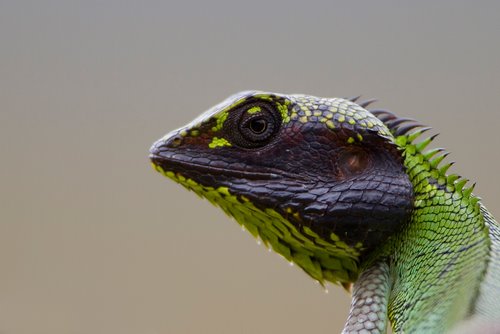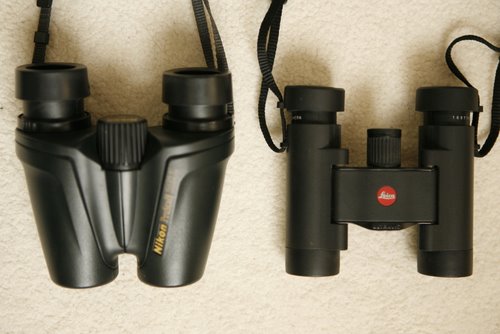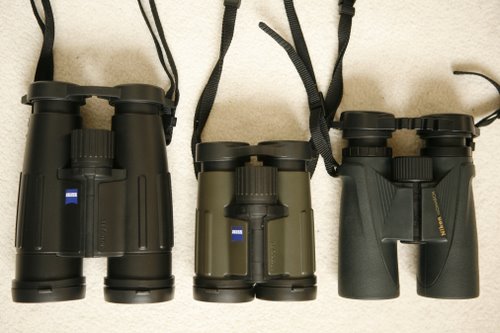My Learning Curve - Part 1
2 (v) Binoculars

A set of binoculars is a real must have for anyone interested in the natural world. There are many occasions when you just can't get close enough to your subjects to get a really good view, I also find they open up a whole new world of detail for insects and birds that you never realized and once you see them in full close-up glory and detail your hooked. They also allow you to observe from a distance therby being less intrusive and allowing you to watch relaxed behaviours.
I am not going to recommend this or that make of binocular here, I just intend to share my thoughts to date on binoculars and the pros/cons involved as I currently understand things.
Just to get the basics squared away the description of binoculars usually follow the following format 8x32 this is read as "eight power/magnification" and a "32" mm objective (or end tube) diameter. This means that an object will appear 8 times closer than it really is. A 32mm objective lens is a guide to how much light the binoculars will let into your field of view. Other usual binocular sizes include 8x20, 10x42, 10x50 etc.
There are also many other metrics e.g. field of view, weight, etc. But I think after magnification and objective lens the next most important factor is minimum focus distance, especially if you intend to view insects.
But what does this mean in practice?
A high magnification may seem to a good thing but you need to remember that it's very difficult to hold binoculars of more than 10 magnification steady, I prefer 8 magnification if I'm 'free standing and viewing' but will use 10 magnification if I'm going to go to a hide and can rest my elbows for support.
A big objective lens may also seem to be an obvious choice, but the bigger the objective lens the bigger the binoculars and the heavier they are likely to be (they may also be slightly more expensive).
Theory says that the human eye can cope with 7mm of light entering it. So if you had a 56mm objective lens and 8 magnification this would give an exit pupil of 7mm (56/8). Any more than 7mm is wasted light for our eyes. Therefore in other words for a 56mm objective lens that you wish to maximise its light gathering ability for (say for twilight viewing) then the maximum magnification you would wish would be 8. An additional piece of theory states that as we age this 7mm number actually falls to around 4mm to 5mm, therefore a set of binoculars with an exit pupil of 7mm may actually be 'wasted' light for many of us and you could therefore take advantage of a higher magnification with no perceivable loss of light gathering ability (hence some much admired manufactures making 10x50 "low light binoculars").
One thing that will never happen is that a pair of binoculars will turn night into day, you need night vision equipment for that. Binoculars just, very usefully, extend your twilight watching experiences when lots of interesting wildlife action occurs.
Nitrogen filled and waterproof is an absolute must for any binoculars you will be using outside.
Regarding your individual choice of binoculars, this is a very personal thing. Everyone has different budgets, likely viewing uses, and differing human characteristics. I would urge anyone to handle as many different types and makes of binoculars as possible before parting with their hard earned cash.
From my experience to date I have settled on the following sizes of binoculars and associated reasoning:

Size Comparison - Left Leica Ultravid BR 8x20, Right Zeiss Victory FL 8x42
8x20 - Leica Ultravid. If I am not using one of the others below, these go everywhere with me. Just think about it for a moment, how many times do you not take binoculars with you because of their size/weight? These are small and light enough to live in any rucksack, jacket or trouser pocket. Admittedly they are not ideal for long term viewing but their sheer practicality of size is the point of these. Being Leica the image quality is first class and they have more than adequate light gathering capabilities during day light hours and are better than the naked eye in twilight use.

Left Nikon ProStaff 8x25, Great Budget Pocket Binoculars. Right Leica Ultravid BR 8x20, Superb Image Quality Pocket Binoculars
8x32 - Zeiss Victory FL. If I were to own just one pair of binoculars this would be the size to choose. The high quality of lenses have very good light gathering ability and their weight/size is very manageable. They are much easier to use for extended viewing than those above and to my hands feel just right. These are in fact my wife's binoculars, but I'm very jealous of them!
8x42 - Zeiss Victory FL. I use these whenever I am going on a planned wildlife watching trip, especially if early morning or twilight viewing is likely. They are larger and heavier than the 8x32's above but I don't find them too cumbersome.
10x42 - Nikon Monarch. These were my first pair of 'proper' binoculars and served me well, they are excellent value for money but for me are best used while being able to rest on something, a shaking image (from the 10 magnification) can be very wearing when undertaking extended viewing. I would also say if you were a birder, and did not have a spotting scope, you may think of 10x over 8x as being important compared to the increased tendency for shaking.

Left to Right - Zeiss Fictory FL 8x42, Zeiss Victory FL 8x32, Nikon Monarch 10x42
I have also owned many cheaper binoculars 10x25, 8x42, 7x42. All these had value in their use and improved my wildlife watching experience no end. However there is a large difference in image quality and viewing experience between the top and bottom flight binoculars. The higher end ones are also easier on the eyes when used for extended viewing.
Regarding manufacturers, all the 'known brands' - Minox, Nikon, Leica, Zeiss, Swarovski etc. produce great quality products for their areas of the market. I would shy away from risking unknown manufacturers unless you have actually field tested them yourself (and against other known manufacturers).
Almost all of my binocular purchases have been second hand from eBay. If you choose wisely and have luck on your side you can make really useful savings on new prices. However it's surprising how top quality binoculars hold their value, they're not the type of thing you're going to buy for half price in pristine condition. Regarding old second hand binoculars, I would say be a bit wary. Modern binoculars have really benefitted from advances in lens technology, lightness of construction and waterproof capabilities (but that's not to say you should rule out this possibility, but I would say be careful).
I would also urge you to learn how to look after them properly, wiping sand of the lenses with your sweat covered tee-shirt is not the thing to do! Investing in a dust blower, some lens cleaning fluid, a lens cloth and disposable lens wipes would be a better way to go, along with actually making use of the lens covers and protective bag they will come in to stop dirt and debris getting on them in the first place.
Therefore in summary I would say:
• Set a budget
• Second-hand upto date binoculars are worth considering, be careful of old binoculars
• Probably best to stick to big brand names
• You do have to pay for image quality and light gathering ability
• Top quality 8x32's will let more light in than cheap 7x56's!
• Handle as many different pairs as you can, do they fit your hands and eye sockets comfortably
• KNOW HOW TO ADJUST THEM TO SUIT YOUR EYES
• They must be nitrogen filled (or similar) and waterproof
• You can comfortably hold 8x pretty steady, 10x tend to shake which can be annoying for some and during extended use
• 10x are good if you know you'll able to rest your elbows/lean on something
• 20mm are small and light (there's no excuse to leave them at home)
• 32mm I would say are the best all-round size
• 42mm I would say this is a minimum objective size for frequent twilight use but be realistic, how often will you actually be using them at twilight? They're a heavy, expensive investment to lug around for normal daylight viewing!
Tweet
Follow @Naturelens
I am not going to recommend this or that make of binocular here, I just intend to share my thoughts to date on binoculars and the pros/cons involved as I currently understand things.
Just to get the basics squared away the description of binoculars usually follow the following format 8x32 this is read as "eight power/magnification" and a "32" mm objective (or end tube) diameter. This means that an object will appear 8 times closer than it really is. A 32mm objective lens is a guide to how much light the binoculars will let into your field of view. Other usual binocular sizes include 8x20, 10x42, 10x50 etc.
There are also many other metrics e.g. field of view, weight, etc. But I think after magnification and objective lens the next most important factor is minimum focus distance, especially if you intend to view insects.
But what does this mean in practice?
A high magnification may seem to a good thing but you need to remember that it's very difficult to hold binoculars of more than 10 magnification steady, I prefer 8 magnification if I'm 'free standing and viewing' but will use 10 magnification if I'm going to go to a hide and can rest my elbows for support.
A big objective lens may also seem to be an obvious choice, but the bigger the objective lens the bigger the binoculars and the heavier they are likely to be (they may also be slightly more expensive).
Theory says that the human eye can cope with 7mm of light entering it. So if you had a 56mm objective lens and 8 magnification this would give an exit pupil of 7mm (56/8). Any more than 7mm is wasted light for our eyes. Therefore in other words for a 56mm objective lens that you wish to maximise its light gathering ability for (say for twilight viewing) then the maximum magnification you would wish would be 8. An additional piece of theory states that as we age this 7mm number actually falls to around 4mm to 5mm, therefore a set of binoculars with an exit pupil of 7mm may actually be 'wasted' light for many of us and you could therefore take advantage of a higher magnification with no perceivable loss of light gathering ability (hence some much admired manufactures making 10x50 "low light binoculars").
One thing that will never happen is that a pair of binoculars will turn night into day, you need night vision equipment for that. Binoculars just, very usefully, extend your twilight watching experiences when lots of interesting wildlife action occurs.
Nitrogen filled and waterproof is an absolute must for any binoculars you will be using outside.
Regarding your individual choice of binoculars, this is a very personal thing. Everyone has different budgets, likely viewing uses, and differing human characteristics. I would urge anyone to handle as many different types and makes of binoculars as possible before parting with their hard earned cash.
From my experience to date I have settled on the following sizes of binoculars and associated reasoning:

Size Comparison - Left Leica Ultravid BR 8x20, Right Zeiss Victory FL 8x42
8x20 - Leica Ultravid. If I am not using one of the others below, these go everywhere with me. Just think about it for a moment, how many times do you not take binoculars with you because of their size/weight? These are small and light enough to live in any rucksack, jacket or trouser pocket. Admittedly they are not ideal for long term viewing but their sheer practicality of size is the point of these. Being Leica the image quality is first class and they have more than adequate light gathering capabilities during day light hours and are better than the naked eye in twilight use.

Left Nikon ProStaff 8x25, Great Budget Pocket Binoculars. Right Leica Ultravid BR 8x20, Superb Image Quality Pocket Binoculars
8x32 - Zeiss Victory FL. If I were to own just one pair of binoculars this would be the size to choose. The high quality of lenses have very good light gathering ability and their weight/size is very manageable. They are much easier to use for extended viewing than those above and to my hands feel just right. These are in fact my wife's binoculars, but I'm very jealous of them!
8x42 - Zeiss Victory FL. I use these whenever I am going on a planned wildlife watching trip, especially if early morning or twilight viewing is likely. They are larger and heavier than the 8x32's above but I don't find them too cumbersome.
10x42 - Nikon Monarch. These were my first pair of 'proper' binoculars and served me well, they are excellent value for money but for me are best used while being able to rest on something, a shaking image (from the 10 magnification) can be very wearing when undertaking extended viewing. I would also say if you were a birder, and did not have a spotting scope, you may think of 10x over 8x as being important compared to the increased tendency for shaking.

Left to Right - Zeiss Fictory FL 8x42, Zeiss Victory FL 8x32, Nikon Monarch 10x42
I have also owned many cheaper binoculars 10x25, 8x42, 7x42. All these had value in their use and improved my wildlife watching experience no end. However there is a large difference in image quality and viewing experience between the top and bottom flight binoculars. The higher end ones are also easier on the eyes when used for extended viewing.
Regarding manufacturers, all the 'known brands' - Minox, Nikon, Leica, Zeiss, Swarovski etc. produce great quality products for their areas of the market. I would shy away from risking unknown manufacturers unless you have actually field tested them yourself (and against other known manufacturers).
Almost all of my binocular purchases have been second hand from eBay. If you choose wisely and have luck on your side you can make really useful savings on new prices. However it's surprising how top quality binoculars hold their value, they're not the type of thing you're going to buy for half price in pristine condition. Regarding old second hand binoculars, I would say be a bit wary. Modern binoculars have really benefitted from advances in lens technology, lightness of construction and waterproof capabilities (but that's not to say you should rule out this possibility, but I would say be careful).
I would also urge you to learn how to look after them properly, wiping sand of the lenses with your sweat covered tee-shirt is not the thing to do! Investing in a dust blower, some lens cleaning fluid, a lens cloth and disposable lens wipes would be a better way to go, along with actually making use of the lens covers and protective bag they will come in to stop dirt and debris getting on them in the first place.
Therefore in summary I would say:
• Set a budget
• Second-hand upto date binoculars are worth considering, be careful of old binoculars
• Probably best to stick to big brand names
• You do have to pay for image quality and light gathering ability
• Top quality 8x32's will let more light in than cheap 7x56's!
• Handle as many different pairs as you can, do they fit your hands and eye sockets comfortably
• KNOW HOW TO ADJUST THEM TO SUIT YOUR EYES
• They must be nitrogen filled (or similar) and waterproof
• You can comfortably hold 8x pretty steady, 10x tend to shake which can be annoying for some and during extended use
• 10x are good if you know you'll able to rest your elbows/lean on something
• 20mm are small and light (there's no excuse to leave them at home)
• 32mm I would say are the best all-round size
• 42mm I would say this is a minimum objective size for frequent twilight use but be realistic, how often will you actually be using them at twilight? They're a heavy, expensive investment to lug around for normal daylight viewing!
Tweet
Follow @Naturelens